Well, well. Look at A New Hope hogging all the Star Wars attention this month. I suppose it’s a big deal that the landmark film is celebrating its 40th anniversary, but like Luke and Han bogarting all the glory from Chewie at the Yavin ceremony, something’s being forgotten. Because there’s another Star Wars anniversary that no one’s talking about:
The 15-year anniversary of the release of Attack of the Clones.
If you’re still reading this, know that I’m being facetious—at least partly. Because, no, Attack of the Clones isn’t equivalent to A New Hope. I’m not a crazy person. But I do love the prequel movies. I love them for the way they expanded the Star Wars universe, I love them for their ambition, and I love them for the tragic story they weaved. I’d even go so far to say that, in a world where tent-pole summer blockbusters couldn’t be more formulaic, the prequels are more deserving of praise than ever. It’ll be a long, long time before we see a big budget franchise display the kind of boldness George Lucas did in those three films. I mean, let’s face it: he could have just remixed the original trilogy. He could have taken his success and replicated it. But he didn’t. For better or for worse, Lucas gave us something different, something unique, and that alone will always be worthy of admiration in my opinion.
That said, while Attack of the Clones isn’t the landmark that A New Hope is, it is a terrific installment in the Star Wars saga, and it deserve more recognition—and not just as a punchline (Have you heard the one about sand being rough? I don’t think we’ve gotten quite enough mileage out of that one yet).
So, to celebrate this much-maligned second episode of the prequel trilogy, here’s 10 reasons why Attack of the Clones is better than you might remember:
The Unseen Adventures of Obi-Wan and Anakin
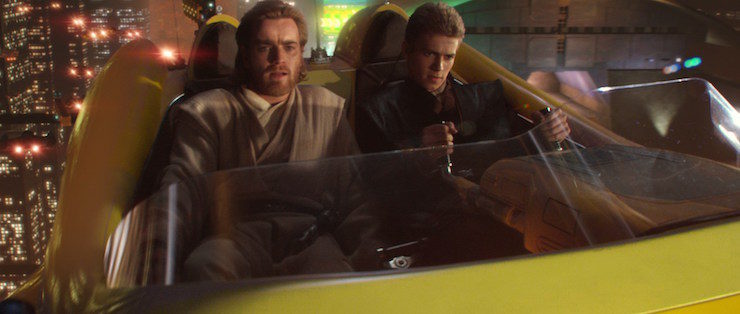
One of the best things about the original trilogy, everyone says, are the things we don’t see. The references to places and events that aren’t explained, the characters who look awesome but never introduced—there’s so much going on within the tapestry of this universe, and it not only helps to make the world feel real, but what was unseen sparked the imaginations of countless people (like me) who had their own Star Wars universes playing out in their heads. When Anakin and Obi-Wan muse about their adventures en route to meeting Padme, I get that same vibe: Anakin and Obi-Wan’s relationship seems lived in, and I want to know more. I want to see Anakin and Obi-Wan trapped in that nest of gundarks. These moments that open up and inspire the imagination, to me, will always be a big part of the Star Wars magic.
Count Dooku: It’s Christopher Lee.
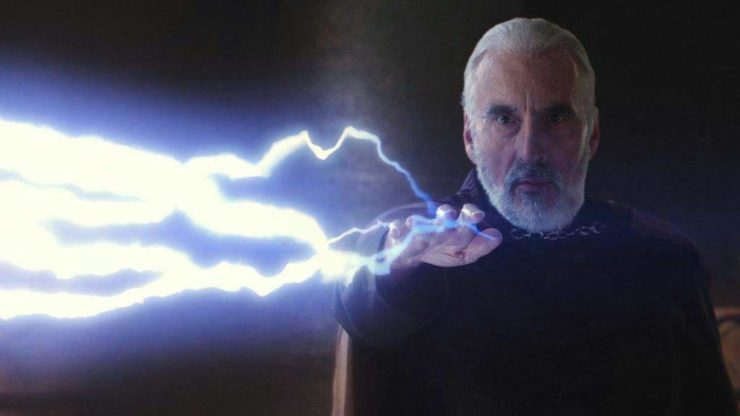
Enough said.
Jedi Noir
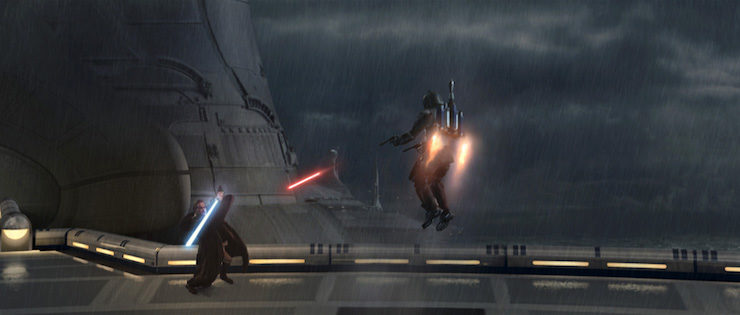
While Anakin and Padme were off…er…romancing on Naboo, Obi-Wan was following the trail of the assassin who tried to kill Padme. Like a Jedi Sam Spade, Obi-Wan operates in the shadows as he follows the trail of the assassin and uncovers a plot that’s bigger than he ever could’ve imagined. In the process, he fights Jango Fett in the rain, gets captured by Count Dooku, and come this close to being fed to the arena beasts on Geonosis. All part of the job for Obi-Wan Kenobi, P.I.
The Nuances of Anakin’s Downfall
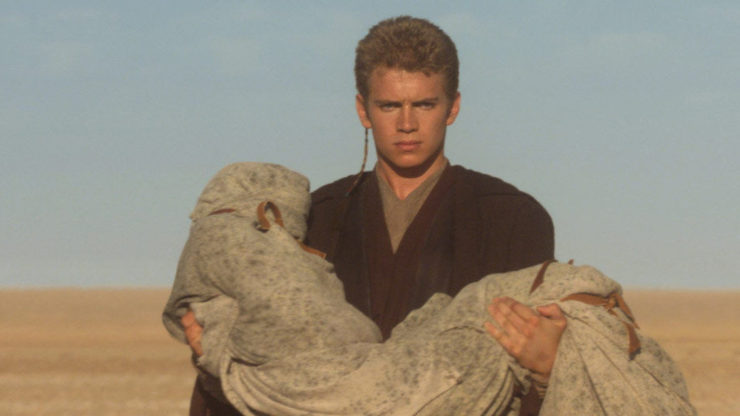
This is an aspect of the entire prequel trilogy that I think is criminally underappreciated. Yes, yes, yes—Anakin’s dialogue is painful at times and Hayden Christensen’s performance doesn’t do much to make the wooden script better. But, there’s some fascinating things happening in Anakin’s fall from grace. I’m of the mind that the Jedi Order is, at its core, problematic; it’s centered on the suppression and denial of very real emotions—love, fear, anger—and when confronted with Anakin, who’s almost all emotion, none of the Jedi have any idea what to do with him (other than tell him to be happy about people dying and to drop the people he cares about like a bad habit, which is what Yoda does in Revenge of the Sith). We forget that Anakin was forced to leave his mother behind when Qui-Gon whisked him off Tatooine—and, oh yeah, she was still a slave. Bye mom! That’s asking a lot of a nine-year-old, and when the only advice you’re given for dealing with your turmoil is to bottle it up, well, that bottle will eventually erupt. Just ask the Tusken Raiders, who became the targets of Anakin’s wrath after they murdered his mom. Not only was Anakin emotionally unprepared to deal with the trauma of violently losing his mother, he had no one to help him with the aftermath. From a certain point of view, the Jedi made Anakin leave his mother behind and, in his absence, she’s brutally murdered. So, yeah, I’d say that Anakin has some complicated emotional issues going on, more than he’s given credit for.
Those Arena Monsters
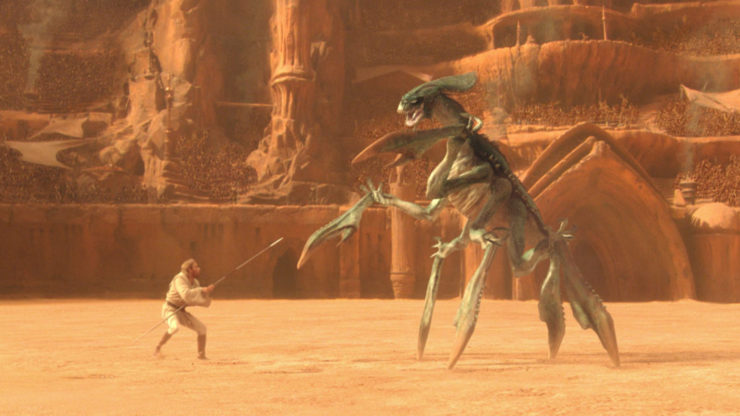
Say what you will about the use of CGI in the prequels, but the three monsters who are unleashed on Anakin, Obi-Wan, and Padme in the arena on Geonosis looked terrific. And that scene is vintage Star Wars.
Jedi Battle
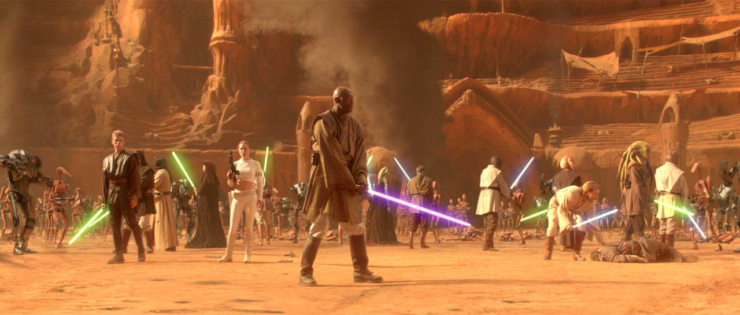
If you’re a fan of Star Wars before circa 1985, you can’t tell me that you didn’t pine to see a bunch of lightsaber-wielding Jedi taking care of galactic business. Granted, the climactic battle in the arena on Geonosis lacked a certain spark—the battle droids never really cemented themselves as an interesting or worthy adversary—but it was still a thrill to see all those lightsabers flashing across the screen.
Ewan McGregor
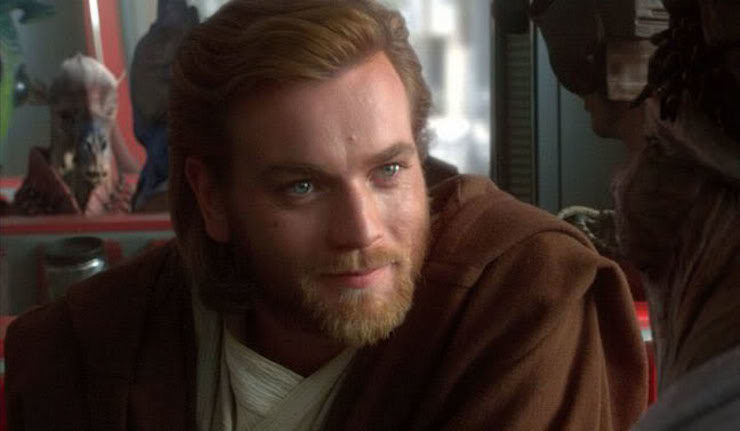
Everyone knows Obi-Wan is the best part of the prequels. He combines dignity, wit, and charisma, and McGregor is pitch perfect in every scene. Please, Disney/Lucasfilm, give us an Obi-Wan/Ewan McGregor anthology movie. We’re begging you.
Kamino
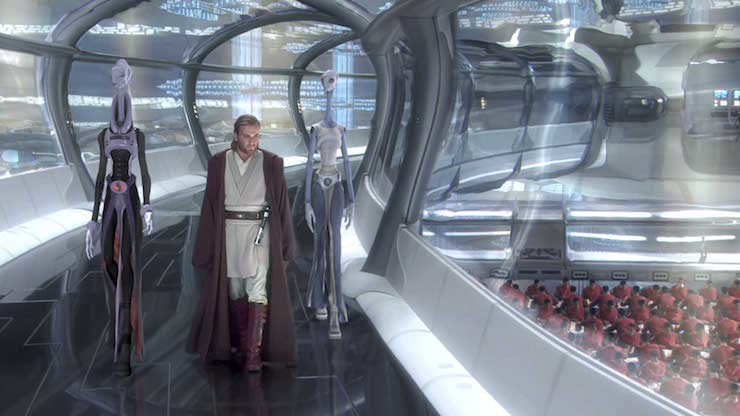
Kamino has always stuck out as one of my favorite locations in the Star Wars galaxy. It’s also, to me, the place where the prequel aesthetic—which carried directly into the animated series, The Clone Wars (more on that soon)—really cemented itself. In The Phantom Menace, the universe doesn’t expand all that much. We return to Tatooine, and we’re never given much of a sense of Coruscant. Which leaves us only with Naboo, which was fine, but it was nothing like Kamino. Kamino exposed us to something new and, quite frankly, super weird and cool. That city on stilts in the ocean—occupied by tall, lithe aliens who specialize in making clones—kickstarted a fresher take on the look and feel of the Star Wars galaxy.
Coruscant Nightlife
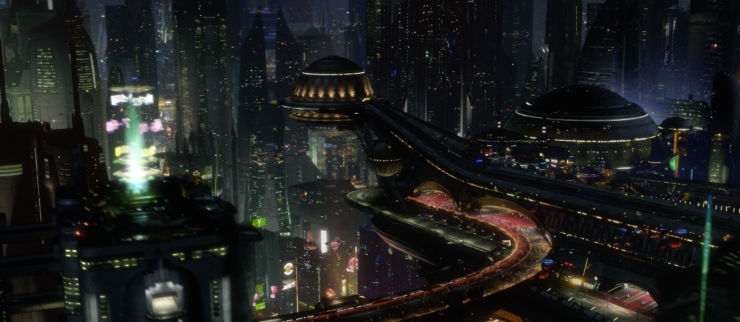
While George Lucas might struggle with dialogue—and he freely admits that he does—he will never lack in his ability to captivate audiences with rich, exuberant visuals. And his depiction of Coruscant at night, via Anakin and Obi-Wan chasing Zam Wessell through the skies and carving through the cityscape, is a testament to Lucas’s fertile imagination and his unparalleled ability to visually tell a story. Coruscant comes alive in this scene, and I personally can’t help but lament what Lucas’s proposed TV series, Underworld—which supposedly focused on the Coruscant criminal element—would have delivered if it had ever gotten off the ground.
The Clone Wars

Spanning one movie and five riveting seasons (well, six, if you count the truncated Lost Missions season), The Clone Wars expanded the Star Wars universe in ways fans had never seen before. Yes, there have been novels and comics and Ewok adventures, but nothing to the scale of The Clone Wars, with a budget (this show was gorgeous) that made every episode feel as epic as any big-screen adventure. Because so much time passed between The Phantom Menace and Revenge of the Sith, The Clone Wars had tons of fertile ground to cover. And boy, did that show ever. I don’t even have the space to list all the amazing things The Clone Wars gave us, but here’s a few: the Obi-Wan/Maul feud; Ahsoka (!!!); Asajj Ventress; the Nightsisters, an awesome version of Anakin; Rex; that H.R. Giger-inspired General Grievous episode; and so much more. None of which would exist without the story and aesthetic established in Attack of the Clones.
There you have it. Are the prequels perfect movies? Nope. But they’re also not worthy of the derision that internet groupthink has poured all over them. There’s a lot of cool things happening in these films—a lot of ambitious things—and with a little bit of patience and an open mind, those aspects can be better recognized. Once that happens, Attack of the Clones transforms from an object of ridicule into a unique and entertaining piece of the Star Wars saga.
I await your pitchforks.
And a small P.S.: All my points are based on canon. You may have the urge to refute or argue what I’ve said with a novel, game, comic, whatever, but for this discussion, if it ain’t canon, it doesn’t count.
Michael Moreci is a comics writer and novelist best known for his sci-fi trilogy Roche Limit. His debut novel, Black Star Renegades, is set to be released in January 2018. Follow him on Twitter @MichaelMoreci.










